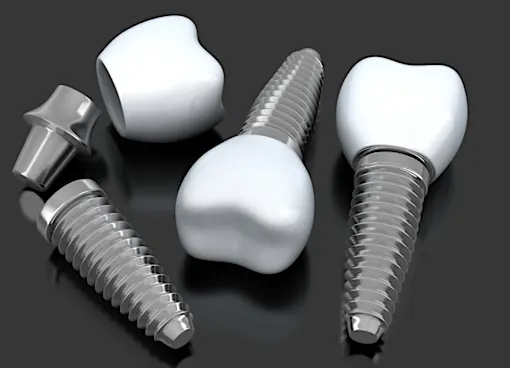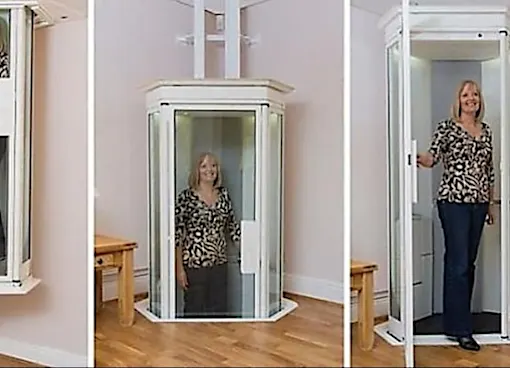Hotels have a long way to go in being truly accessible.
Ihave used a wheelchair since I was 12 years old. And, yes, though there was an adjustment period, though it took time to reconcile myself to life on wheels, I soon came to recognize the distinct advantages my chair offered me.
I was diagnosed with rheumatoid arthritis at the age of 20 months, and by the time I became wheelchair-dependent, the RA had spread to all extremities and every joint, causing deformity, muscle weakness, often severe pain, and extreme loss of mobility.
That meant that propelling myself about with a manual wheelchair wasn’t an option. And, due to significant hip and spine involvement, it also meant that a standard motorized wheelchair wouldn’t do.
TOP PICKS FOR YOU



RECOMMENDED FODOR’S VIDEO
To be able to tolerate spending more than an hour or two out of my electric hospital bed, I would need a chair that could accommodate my complex needs. I would require a chair that could tilt, recline, and elevate–the works.
In other words, I would need a chair that offered me the freedom of movement that my body did not.
And a chair like that comes at a premium, not only in price but in size. Think “small barge,” and you’ll be on the right track. What the chair lacks in compactness, though, it more than makes up for in comfort and utility.
With the chair, I enjoy a measure of independence that would otherwise be unthinkable. I no longer need help repositioning myself in the seat. I no longer have to return to my bed to find relief from the pressure on my lumbar spine. Best of all, I don’t have to ask to be wheeled from place to place. When I am out and about, I am able to autonomously go wherever my whim and four wheels can take me.
Well, almost.
There’s a flip side to such a sweet ride, as anyone who depends on a souped-up motorized wheelchair or otherwise outsized mobility aid can tell you. It’s the simple reality that even ADA-compliant constructions typically aren’t built to accommodate our specialized equipment, nor do they always allow guests with complex needs to lodge in comfort and ease.
The Labyrinth of Lodging Challenges
When you have a complex disability, and you decide to hit the road, you learn pretty quickly that the challenges you might face at home are often nothing when compared with the obstacles you’re likely to face when you venture beyond your usual stomping grounds.
I have learned this lesson time and again when I travel, which is something I love to do. In fact, it was at a recent academic conference held in a luxury hotel in Baltimore, Maryland, that I truly began to appreciate the limits of “accessible” design for persons with complex disabilities such as mine.
Ironically, I had been invited to speak on a disabilities studies panel, but the labyrinth of obstacles that unexpectedly sprang up during our stay revealed more about the accessibility barriers persons with disabilities face than the disability conference ever could.
To be sure, none of this is meant to cast aspersions on the hotel, one of the finest in the city, or its staff, who were kind and conscientious. The hotel’s amenities were grand. The service was assiduous. The property was beautifully maintained and, as far as I could tell, wholly in adherence with ADA standards.
Mountains and Molehills
For all its amenities and for all the rigor that had obviously gone into meeting and exceeding “accessibility” standards, our fine accommodations did not prove very accessible at all.
Because of my particular needs, my family and I were forced to make do, improvise, and ultimately do without the full access I had expected and desired. We were, for instance, compelled to forgo the opening night reception because the ballroom where the event was held could only be accessed by descending a flight of three stairs. Though a wheelchair lift was installed at the landing, it could be operated only with a key, which none of the hotel staff could locate (this is by no means the first time I have encountered such an issue with a keyed wheelchair lift in a public building).
I have heard of such issues time and again in others who use power wheelchairs, scooters, and other motorized mobility aids. Seemingly small obstacles that others might pass over without even noticing can prove insurmountable when you’re non-ambulatory. And they’re all too prevalent, even in ADA-compliant rooms. High thresholds at entryways, balconies, and patios can render entire sections of an “accessible” room off-limits. Sunken lobbies and reception areas can turn a rise of just two or three steps into an immovable barrier.
Battling the “Accessible” Bathroom
Turns out, it wasn’t just accessing the reception area that proved problematic. We also encountered issues with the bathroom in our “accessible” hotel room. Though it would have been more than spacious enough to accommodate a walker or manual wheelchair, with my motorized behemoth, being inside the bathroom was a bit like parallel parking a semi on a postage stamp. ADA requirements for accessible hotel bathrooms require enough clearance for a 60-inch diameter circle or “T” turn. That may be sufficient in many cases, but for those with “special” special needs, that’s often far too little space to use the facilities safely and comfortably.
For instance, in addition to the extended chassis size of my chair, I, like many persons with musculoskeletal disorders, do not have knee joint mobility. My legs are fixed at full extension, and even at 5’3”, my legs alone take up most of the space in an ADA-compliant bathroom.
Attempting to access the toilet, sink, or shower when you have very limited mobility and a large footprint can feel very much like a game of human Tetris. However, the challenges usually don’t end once you’ve done all the geometric calculations you need to actually get to the sink, commode, or bathtub.
For me, one of the most harrowing experiences of my stay came when I tried to use the shower. Per ADA requirements, the hotel had affixed a hard plastic shower bench to the back stall. Unfortunately, the dimensions of the bench were fairly stingy, but because of my hip and spine issues, I am unable to sit at a 45-degree angle. The slightly reclining position at which I must sit required me to, in essence, cling to the edge of the shower bench to keep from slipping off while the back of my head ground against the hard marble tile of the shower wall. The firm plastic of the shower bench made my lower back scream. And so, between the pain in my head and back and the fear of falling, I usually ended each shower in tears.
But I am certainly not the only one to find shower stalls a challenge. Many ostensibly accessible rooms are now provided with bath chairs rather than affixed benches. As anyone who has ever used them knows, bath chairs are notoriously unstable, particularly if you need to use a transfer board. The curved edges of most bath seats make them function pretty much like a reverse seesaw. Those little suckers tend to tip sideways if you so much as breathe on them too hard. If you have balance issues or limited mobility, that can be the perfect recipe for a dangerous fall.
No Rest for the Weary
You definitely have a lot of ducks to line up when you have a complex disability and you’re preparing to travel. For me, though, one of the most important and difficult issues has always been figuring out how I am going to sleep on the road.
At home, I’ve used a fully electric hospital bed for decades. Stationary beds just don’t provide the support my limbs and spine need. Worst of all, I can’t reposition myself in a stationary bed, nor can I move into a sitting or semi-sitting position. This makes it both painful and difficult to breathe. To be sure, bed wedges can help in a pinch, but if you have a severe pain condition, limited mobility, or breathing issues, wedges can’t compare with the ease of an adjustable bed.
And it’s not just the kind of bed you have to worry about. You also need to consider how you’re going to get into and out of it. Platform and high-profile beds may look deliciously stylish, but they can be a nightmare if you are not very mobile. Beds that are very high or low can be uncomfortable and dangerous for those who use a transfer board or who have trouble bending or climbing. Likewise, platform beds can be wholly unusable if you need clearance under the bed for your mobility equipment or a Hoyer lift.
Tips for Putting the “Access” in Accessible
Traveling when you have a complex disability can be daunting, but it is also most certainly doable. Above all, disability cannot, must not, and should not deprive you of one of life’s great pleasures: travel. The key is to know what to look for and plan ahead. So, if, like me, you are one of the thousands of people with “special” special needs, here’s some advice.
Do a Virtual Walk-Through
Before you book your hotel, reach out to the concierge or guest services team and request that they do a virtual walk-through with you. Ask them to video in real-time every area you will want to access during your stay. Get images and, ideally, measurements of thresholds and doorways. Try to have as much of a 360-degree view of the space as you can because often, you will spot instantly potential barriers an able-bodied person might never notice.
Consider Home Comforts
When you’re thinking about what you might need to travel safely and comfortably, look around you. Make note of the essential things you use daily, perhaps even without thinking about them, to make your life easier and more functional. Then spend some time figuring out how you might emulate that at your chosen hotel. For instance, I use a portable shower bench with a transfer pad at home. The seat is generously proportioned and consists of padded vinyl, meaning that it allows me to recline at the slight angle I need without feeling as if my hips and spine are being ground to a fine powder as they would with a harder seating surface.
Be Your Own Best Advocate
As revolutionary as the ADA has been for persons with disabilities, the statutes aren’t without limits. Businesses are only required by law to provide “reasonable” accommodations for guests and patrons with disabilities. That’s a pretty murky line and one that, all too often, does not go far enough to meet the needs of those with complex challenges. But that doesn’t mean, though, that hoteliers will be unwilling to go the extra mile for their guests. After all, that’s what the hospitality industry is all about, right?
So don’t be afraid to ask for what you need. If you need an adjustable bed, collaborate with guest services to see what options might be available. If you need to bring your own shower bench or portable ramp, fight for that right. When you advocate for yourself, you’re not just asserting your own accessibility rights, you’re also smoothing the path for those who will literally and figuratively follow in your footsteps and/or tire tracks!

10 Baking Books You’ll Want to Gift This Holiday Season
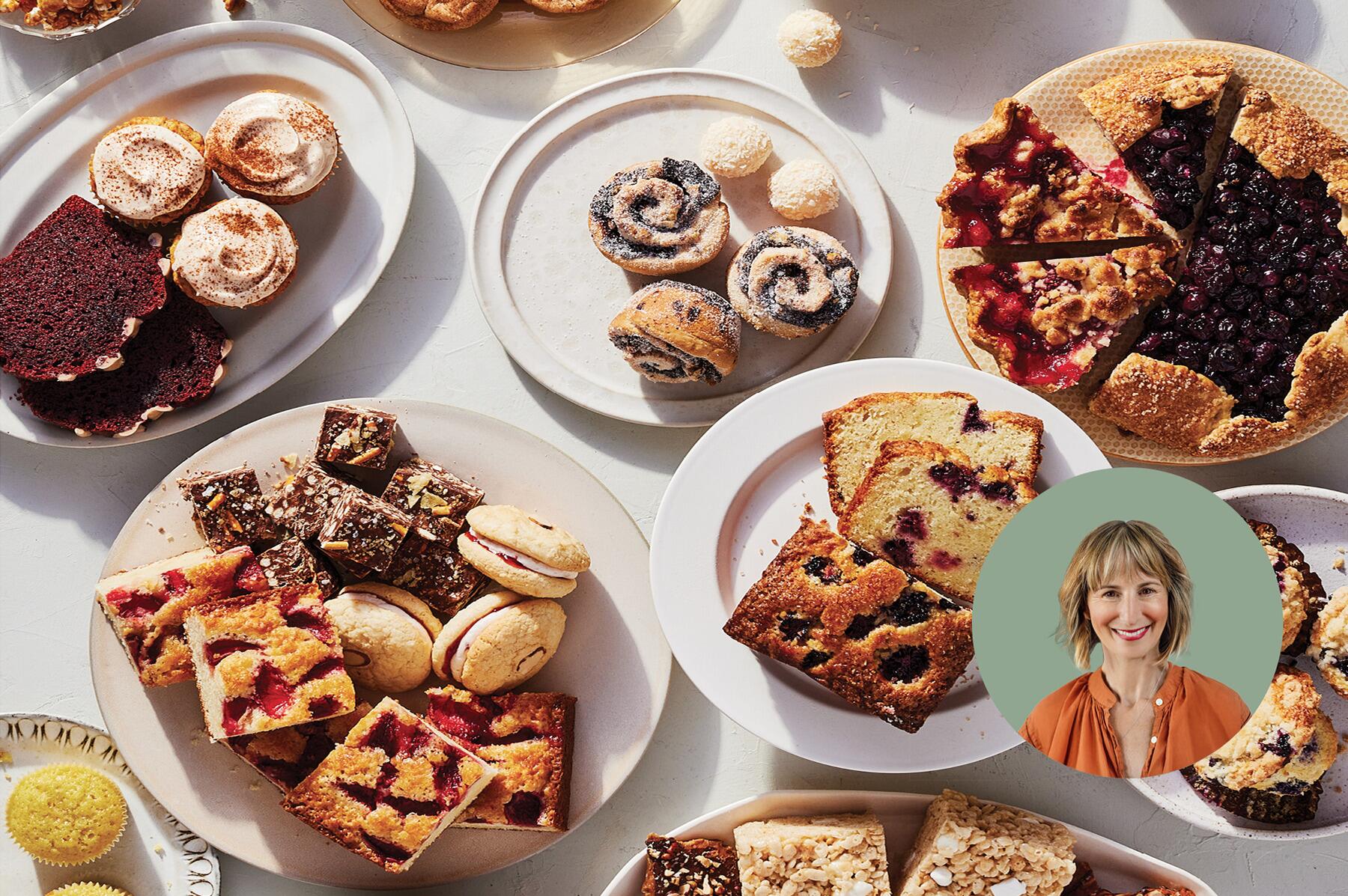
You’ll Savor Every Crumb In This Delightful and Dead Simple Cookbook
Jessie Sheehan, author of November's Book Club pick, 'Snackable Bakes,' sits down with us for a little sweet talk.
You could describe Jessie Sheehan and her deliciously divine bakes the same way—joyful, over the top, and completely delightful. A bout of excitement and infectious energy, her playful social media presence over the pandemic made many fall in love with her (and her sweet treats.) Living the sweet life (don’t worry, this piece contains puns ‘a plenty) in her Red Hook, Brooklyn, apartment with her family, she’s an actress turned lawyer turned professional baker, recipe tester, and recipe developer. It’s her many titles, can-do attitude, and approachable, laid-back vibe that have influenced her latest cookbook, a perfect pick for the harried hustle of the holidays.
Snackable Bakes made the cut for our November Book Club pick, because, let’s face it, this time of year is painful enough—so let’s make the treats simple and delicious. But wait, back up a little…wtf is a “snackable bake”?
Jessie defines them as “easy, peasy” type recipes that rely heavily on pantry staples and minimize prep and dishes. Like her Orange Buttermilk Olive Oil Morning Muffins or her Salty Snack Fudge (hello, potato chips as an ingredient!). There are big, beautiful pictures to accompany every recipe, subs and swaps galore, and everything feels easy and approachable. As our Lord and Savior Ina Garten once said, “Now how easy is that?”
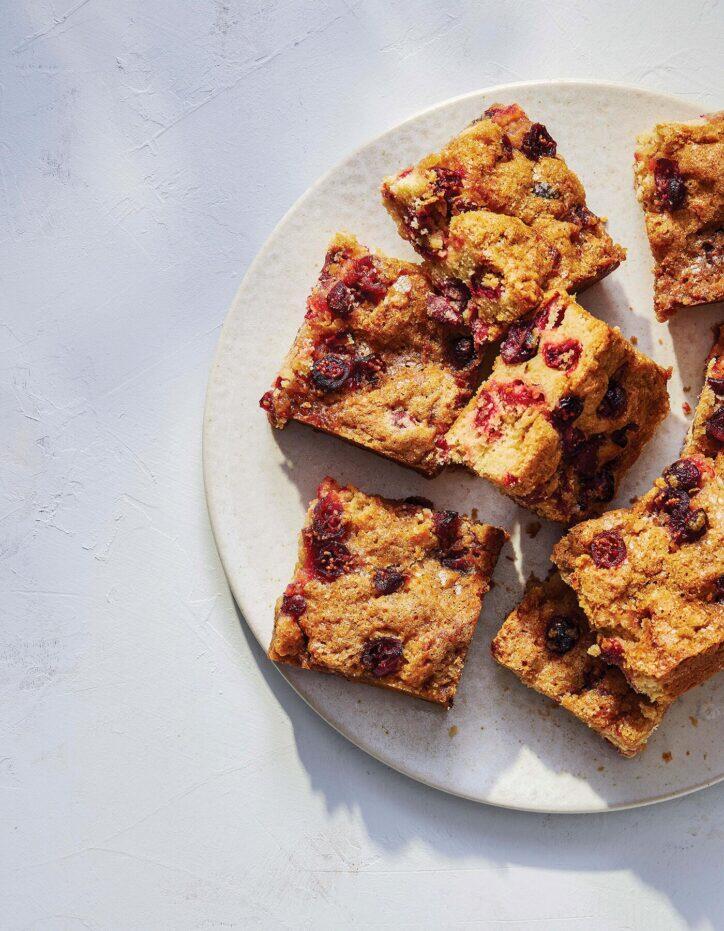 Countryman Press
Countryman Press Jessie also did us the pleasure of being a bit of a holiday helper over on our Instagram. Catch us making her Cranberry Vanilla Breakfast Buckle and answering your holiday baking 911s.
Learn more about Jessie’s resume, her favorite holiday travel destination, and what recipes from Snackable Bakes we should devour this season.
FODOR’S BOOK CLUBWant to read more interviews like this? Make sure you’re signed up for Fodor’s Book Club. You’ll be reading our monthly picks alongside thousands of Fodor’s readers, be entered into exclusive giveaways and contests, and get more fun book-related content delivered straight to your inbox.
FODOR’S: What do you think is the biggest mistake people make when baking?
JESSIE SHEEHAN: I think people tend to mismeasure their flour when they are measuring by volume, rather than weight. There are several different ways to measure flour. Some people use a spoon to fill a measuring cup, some people fluff and scoop to fill one, and some people don’t fluff at all (the horror). Each technique results in a different amount. Because baking requires precision, adding even a little too much or not adding quite enough can negatively impact the final product. In short, though I hate to encourage the purchase of additional kitchen items, a scale can dramatically improve your baking.
The other biggest mistake (because I believe there are two) is that people are baking in ovens that are not properly calibrated, meaning they are either running too hot or too cold. When an oven is too hot, cakes overbake and are dry, and cookies burn. And when it is too cold, the outside of a baked good might look perfect, but the inside is often raw. Bottom line: buy an oven thermometer.
The third biggest mistake (sorry, I realized there are three) is that people overmix their batters and doughs. Once flour is added, the key is to use a gentle touch either with your spatula if you are mixing by hand or by lowering the speed on your mixer.
What three ingredients do you think people should always have on hand for baking besides the obvious (sugar, flour, etc.)?
I think sour cream is the most wonderful addition to cakes and even to biscuits and scones and muffins. I love the tang and richness it imparts, and you can often substitute it for milk in a recipe.
I think it is nice to have some bread flour on hand because you can substitute it for some of the all-purpose flour in your cookie recipe, resulting in the chewiest of textures.
I adore sweetened condensed milk and like to add it to my Rice Krispies Treats and coconut macaroons, and it is essential when making no-churn ice cream. It lasts forever, so can be kept in the kitchen cabinet for a long time.
Oh, and I also love heavy cream because I am extra and love adding additional fat and richness to my bakes (sorry haters).
Do you have any early baking memories?
I don’t have early baking memories—unless you count my late 30s as “early”—but I have lots of early sweets-eating memories. There weren’t a lot of from-scratch bakers in my childhood orbit, but my paternal grandmother did make the most delicious tiny little crispy Tollhouse Cookies (and I can’t even believe I’m writing that, as I am team jumbo or go home, and I hate crispy cookies), as well as an incredible lemon sheet cake that I learned as an adult was actually from a box (rather than be disappointed, it was an “aha” moment, as I realized that that must be where my deep affinity for cakes from a mix was born). In addition to these “homemade” items, I also remember with the deepest of affection Double Stuf Oreos, Drake’s Devil Dogs, and Pepperidge Farm Raspberry turnovers always stocked in my childhood kitchen.
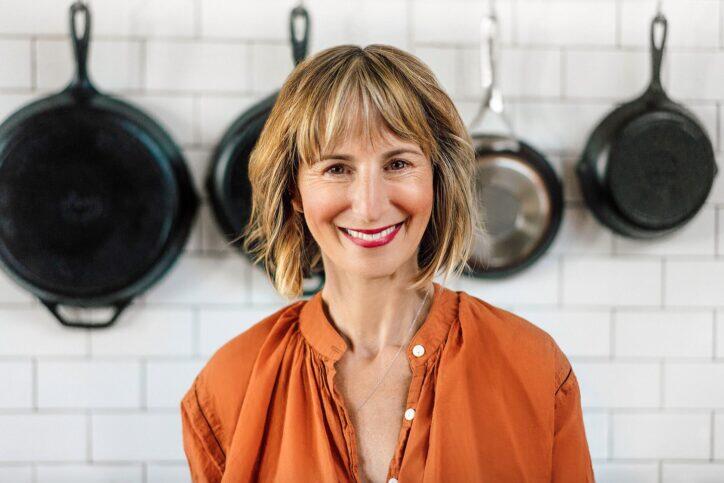 Countryman Press
Countryman Press What are the top recipes from Snackable Bakes you’d recommend for the holidays?
The Vanilla Cranberry Buckle is fabulous on T’giving morning; the Devils Food Snacking Cake with Marshmallow Frosting and the Grasshopper Whoopie Pies (but with the Candy Cane twist, which is included in the book) are both perfect around Christmas. And I love the Tiny Lavender Shortbread Bites for cookie swaps. The Pumpkin Snacking Cake with Chocolate Buttercream is a great option instead of pumpkin pie for turkey day, and the Butter Cracker (aka Ritz Cracker) Brittle with Toffee and Chocolate and Pecans is excellent for munching on with a glass of champagne on NYE.
Red Hook is such a great neighborhood, and we love joining you from your kitchen there. Where are your favorite spots in the neighborhood for eating and hanging out?
I adore Good Fork Pub (run by my pals and neighbors Sohui Kim and Ben Schneider). I adore Grind Haus (run by my friend Erin Norris) and Billy Durney’s restaurants Red Hook Tavern and Hometown (and Billy is also a pal). I’ve lived in Red Hook a long time and am happy to call the restaurateurs here my friends. I live near Valentino Park, and it is an awesome spot to check out an epic view of the Statue of Liberty. Oh, and Court Street Grocers sells delicious sandwiches–buy one and head to Valentino.
If someone only had a weekend in NYC, where would you recommend they grab sweet treats from?
I adore the brownie at Mah Ze Dahr bakery; I love the donuts and buns at Fan Fan, the cake and cookies at Ovenly, and the cruller at Daily Provisions.
Tell us about your time at Baked in Red Hook and what it was like to make such a big career transition.
My time at Baked was so special as I not only learned the baking and sweets-making ropes there, but I also discovered a passion for making treats that I didn’t know I had. I had worked as an actress, a lawyer, and a stay-at-home mom before I went into Baked and asked them to teach me the tools of the trade, and although they were a little put-off at the request (random moms don’t tend to walk in off the street, offering to work for free in exchange for baking training), they acquiesced, and the rest is history. Moreover, I made great friends at Baked, one of whom tested all the recipes for Snackable Bakes AND has a cookie named after her in the book (Epic Snickerdoodles for Stephanie). The career transition was indeed major, but it ended up being so right for me personally and professionally that it hardly seemed daunting. Plus, the work at the bakery led directly to working on cookbooks as the owners of the bakery were writing their first book when I arrived. And so the experience of working there led to more than just a love of sweets-making; it led to a love of working on cookbooks–from testing to developing recipes for them to writing my own a few years later. Seems like some kind of crazy delicious kismet that I walked in there that day to ask for a job and ended up with a career that I adore.
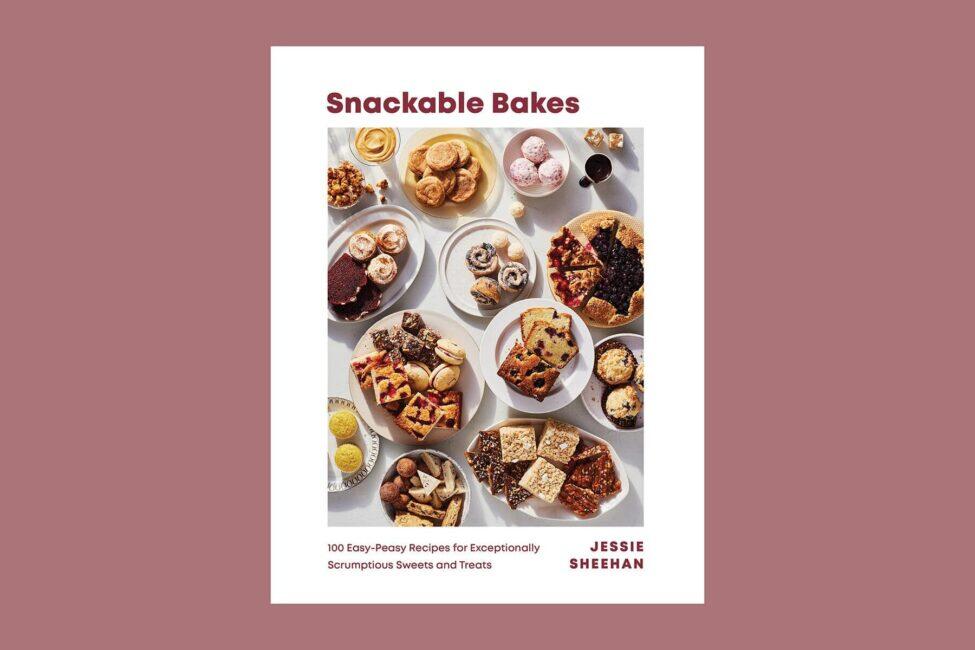 Countryman Press
Countryman Press You’ve also spent time as a recipe developer. Please tell us what that is like! We’d love to know what your favorite recipe from Snoop’s cookbook is, too (Jessie did R&D on his cookbook, From Crook to Cook).
I love recipe development, and it is really the bread and butter (or cake and frosting) of what I do as I still develop recipes for a variety of online sites (like Food52 and The Kitchn) as well as the Washington Post, among others. And, yes, I have also developed recipes for cookbooks other than my own, like the Baked books and Snoop’s cookbook. I developed several recipes for Snoop’s cookbook, but I think the Gimme S’more Pie is my favorite of the bunch.
Why do you think so many people took up baking as a hobby during the pandemic?
Now it sounds like a bit of a cliché, but it truly is a comforting and often nostalgic pastime that can give you all the feels when you are not quite yourself emotionally. Because I do it for a living, I don’t exactly feel all warm and cozy when I bake, but I definitely understand how the experience of making pie dough by hand or biting into a still warm and melty chocolate chip cookie or being handed a plate with a huge slice of layer cake iced in billowy American buttercream frosting, can be super calming. It can settle and center you in a way lima beans are never going to be able to–and I have nothing against beans. I’m just here to recognize and pay homage to the magical power of the sweet treat.
Since we’re a travel publication, tell us about one of your recent vacations or favorite vacations and why you loved it so much. What did you eat?
Every other Christmas for the last three years, I have gone to Uruguay with my husband and two boys, and some family friends. We stay in Jose Ignacio, a chic, bohemian, laid-back little beach town, and it is not only an incredibly beautiful place to visit—both the landscape and the people are just gorgeous—but the food is off the charts, particularly for those of us that love meat. Francis Mallmann has a restaurant in Garzon, a nearby town where everything is cooked on an open flame. The meat and vegetables are spectacular. The seafood is particularly incredible at La Huella in Jose Ignacio.
‘Snackable Bites by Jessie Sheehan (published by Countryman Press) is available now in hardback and e-book.














![[Pics] Pour Salt Down Your Drain At Night, Here's Why. [Pics] Pour Salt Down Your Drain At Night, Here's Why.](https://images.outbrainimg.com/transform/v3/eyJpdSI6ImM1ZDIxZjczMThhOTU0ODg2M2MzNWRiZmY0ZDljZTg4MDE1MTQ4NWY0YTg4MWQyNzI2M2VkNDQxOTM3N2Y1ZTYiLCJ3IjozNDAsImgiOjI0NSwiZCI6MS41LCJjcyI6MCwiZiI6NH0.webp)
